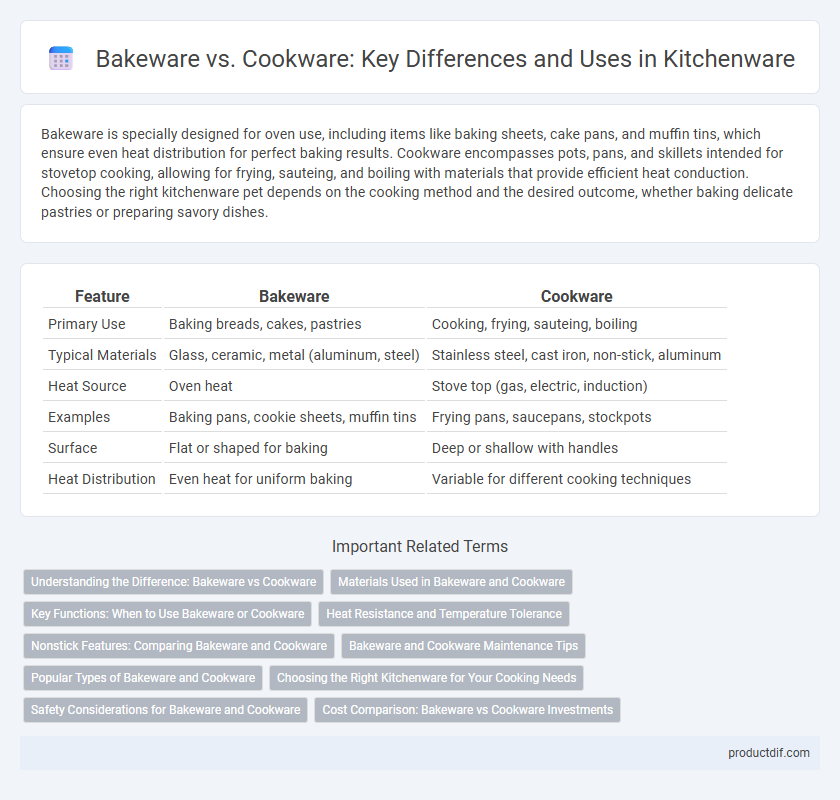Bakeware is specially designed for oven use, including items like baking sheets, cake pans, and muffin tins, which ensure even heat distribution for perfect baking results. Cookware encompasses pots, pans, and skillets intended for stovetop cooking, allowing for frying, sauteing, and boiling with materials that provide efficient heat conduction. Choosing the right kitchenware pet depends on the cooking method and the desired outcome, whether baking delicate pastries or preparing savory dishes.
Table of Comparison
| Feature | Bakeware | Cookware |
|---|---|---|
| Primary Use | Baking breads, cakes, pastries | Cooking, frying, sauteing, boiling |
| Typical Materials | Glass, ceramic, metal (aluminum, steel) | Stainless steel, cast iron, non-stick, aluminum |
| Heat Source | Oven heat | Stove top (gas, electric, induction) |
| Examples | Baking pans, cookie sheets, muffin tins | Frying pans, saucepans, stockpots |
| Surface | Flat or shaped for baking | Deep or shallow with handles |
| Heat Distribution | Even heat for uniform baking | Variable for different cooking techniques |
Understanding the Difference: Bakeware vs Cookware
Bakeware refers specifically to items designed for oven use, such as baking sheets, cake pans, and muffin tins, optimized for even heat distribution and non-stick surfaces. Cookware encompasses a broader range including pots, pans, and skillets intended for stovetop cooking, focusing on heat conductivity and durability for frying, boiling, and sauteing. Understanding the difference helps select the right tools based on cooking method and food type, enhancing culinary results and kitchen efficiency.
Materials Used in Bakeware and Cookware
Bakeware commonly utilizes materials like aluminum, silicone, glass, and ceramic, which provide even heat distribution and non-stick properties essential for baking delicate items. Cookware often features stainless steel, cast iron, copper, and non-stick coatings designed to withstand high temperatures and facilitate various cooking techniques such as frying and sauteing. The material choice directly impacts heat conduction, durability, and food release, influencing overall cooking performance in both bakeware and cookware.
Key Functions: When to Use Bakeware or Cookware
Bakeware is designed specifically for oven use, ideal for baking bread, cakes, and pastries where even heat distribution is essential for proper rising and texture. Cookware, including pots and pans, is intended for stovetop cooking methods such as boiling, sauteing, and frying, providing direct heat control for diverse recipes. Choosing between bakeware and cookware depends on the cooking technique--bakeware excels in dry heat applications, while cookware is essential for moist or high-heat stovetop preparations.
Heat Resistance and Temperature Tolerance
Bakeware, typically made from materials like ceramic, glass, or silicone, offers excellent heat resistance and can withstand temperatures ranging from 350degF to 500degF, making it ideal for oven use and consistent baking results. Cookware, often constructed from metals such as stainless steel, cast iron, or aluminum, exhibits superior temperature tolerance with rapid heat conduction and the ability to handle both high stovetop temperatures and oven use, often exceeding 600degF. Understanding the distinct heat resistance and temperature tolerance between bakeware and cookware ensures optimal cooking performance and durability in various kitchen applications.
Nonstick Features: Comparing Bakeware and Cookware
Nonstick bakeware typically features silicone or ceramic coatings designed for even heat distribution and easy food release during baking. Cookware nonstick surfaces often use polytetrafluoroethylene (PTFE) or ceramic materials, providing superior resistance to high heat and abrasion while minimizing oil usage. Comparing bakeware and cookware nonstick features reveals that bakeware prioritizes gentle, consistent heat and chemical-free coatings, while cookware emphasizes durability and performance under direct stovetop heat.
Bakeware and Cookware Maintenance Tips
Proper bakeware maintenance includes hand-washing with mild detergent to prevent warping and removing baked-on residues by soaking in warm water. Cookware longevity improves by seasoning cast iron regularly and avoiding abrasive cleaners that damage nonstick surfaces. Storing both bakeware and cookware in dry, well-ventilated areas reduces rust and prolongs usability.
Popular Types of Bakeware and Cookware
Popular types of bakeware include metal baking sheets, silicone molds, glass casserole dishes, and ceramic pie plates, all designed to evenly distribute heat for optimal baking results. Cookware commonly consists of stainless steel pots, non-stick frying pans, cast iron skillets, and pressure cookers, each suited for different cooking methods such as sauteing, boiling, or slow cooking. Choosing the right bakeware or cookware depends on the cooking technique and desired durability, heat conductivity, and maintenance requirements.
Choosing the Right Kitchenware for Your Cooking Needs
Bakeware consists of items such as baking sheets, cake pans, and muffin tins designed specifically for oven use, ideal for baking bread, cakes, and pastries. Cookware includes pots, pans, and skillets suited for stovetop cooking, perfect for sauteing, boiling, and frying. Selecting the right kitchenware depends on your primary cooking methods, with bakeware optimized for precise heat distribution in baking and cookware engineered for quick temperature adjustments and versatility on the stove.
Safety Considerations for Bakeware and Cookware
Choosing bakeware and cookware requires attention to material safety, such as opting for non-toxic, heat-resistant options like borosilicate glass or anodized aluminum to prevent harmful chemical leaching. Avoiding cookware with damaged coatings or excessive wear reduces risks of ingestion of toxic particles during cooking. Proper use also involves ensuring compatibility with cooking temperatures to prevent warping or release of hazardous fumes, enhancing overall kitchen safety.
Cost Comparison: Bakeware vs Cookware Investments
Bakeware typically costs less upfront than cookware, with basic sets priced between $20 and $100, while quality cookware sets can range from $100 to over $500. Investing in durable bakeware made from materials like silicone or glass offers affordability for casual baking, whereas stainless steel or cast iron cookware demands higher initial expense but ensures long-term savings through enhanced durability and heat retention. Buyers should balance budget constraints with intended use, as cookware investments often yield better value for versatile, everyday cooking.
Bakeware vs Cookware Infographic

 productdif.com
productdif.com